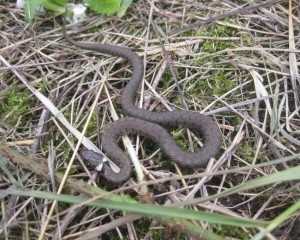
A group of Wren Group members, with support from the City of London Corporation, set out to find which reptile species were present in the Exchange Lands (Old Sewage Works) between the Empress Avenue allotments and the River Roding. At the beginning of September, some 40 roofing felt refugia were laid in the area by a forest keeper and Alison Tapply. The felts were about 60 x 60 cm in size. Most (30) were placed on open grassland or at the margin of grass and hawthorn or brambles in the western section of the Exchange Lands, with the other 10 in the lower part of the area, closer to the River Roding. Some of the latter were in some very long grass though others were sited on shorter grass close to the cycle way running to the bridge over the river.
The rationale of using dark-coloured felts that absorb the sun’s heat is a tried-and-tested method. Once warmed by sunshine the felts become attractive to reptiles needing to increase their body temperature, since they are ectotherms (cold blooded). However, this method assumes that there is someone on hand to check the felts as they get warm – rarely the case with only a small team of volunteers doing the checking. Occasionally reptiles may be found under a refuge early in the morning, having spent the night there, or at dusk. It is worth noting for the future that the felts in the longer grass rarely became warm because of the shading effect of the grass, and this was reflected in there being no observations in that area.
The felts were checked from 4 September to 30 October. During September they were checked, on average every other day when conditions were mostly dry. There were some wet spells during the month when it wasn’t felt to be productive to check. In October the refugia were checked, on average two or three times per week. If more volunteers had been available, the checking could have been more regular.
Findings
Despite anecdotal evidence of Slowworms from people working the adjacent allotments, none were found. Neither were any Common Lizards seen. However, a good number of Grass Snakes, both juveniles and older animals, were noted between 4 September and 15 October. Grass Snakes were seen under six different refugia, with three juveniles under a single felt on 6 September being the most found on any one date. Breaking the observations down week by week, the following pattern emerges:
Sept week 1: 4 juveniles
Sept week 2: 7 juveniles
Sept week 3: 1 young adult
Sept week 4: 1 young adult
Oct week 1: none
Oct week 2: none
Oct week 3: 1 young adult
Oct week 4: none
Conclusions
Grass Snakes are apparently thriving in the Exchange Lands and, since juveniles were found under four felts (in two clusters of two, which were some distance apart), it is safe to assume that they bred in the area. It is hoped to have more refugia set out in the area in spring 2016, with the aim of getting more information on the status of Grass Snakes and – who knows – find a Slowworm or two.
Thanks to all those who helped with the checking, especially Gill James, and also to Barry Chapman, Nick Croft, Kathy Hartnett, James Heal, Sharon Payne, Rose Stevens, Alison Tapply, and Bob Vaughan.